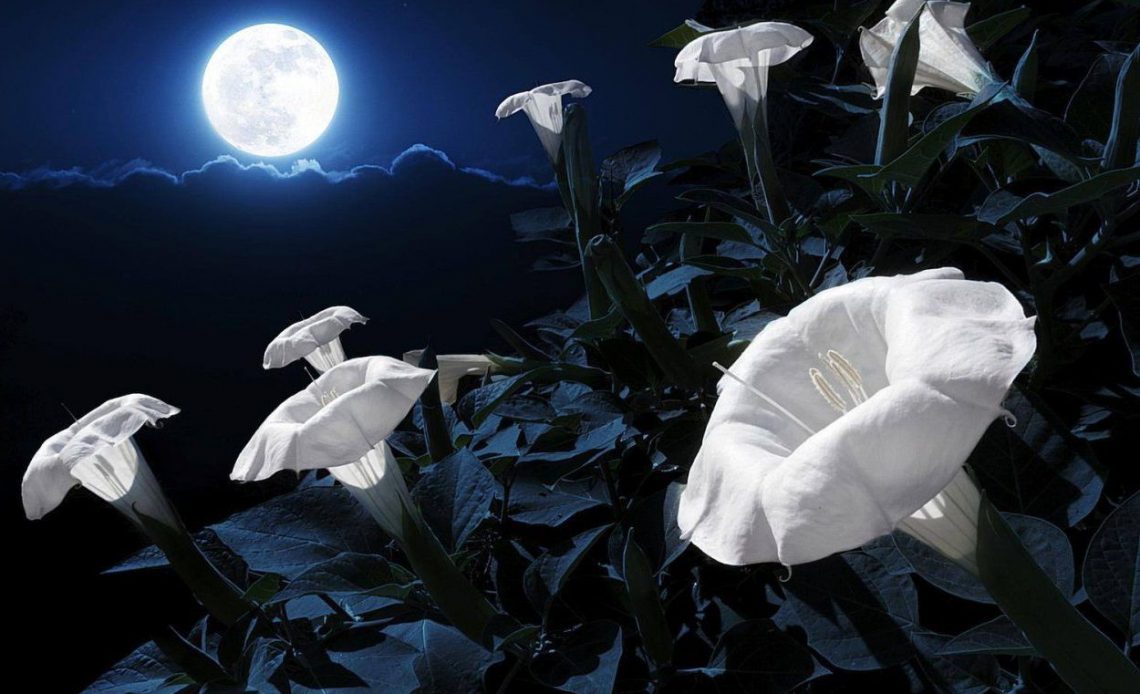
As the sun sets and the moon takes its place in the sky, a different set of flowers bloom, lighting up the garden with their beauty. These are the flowers that bloom at night, each representing the moon in their unique way.
What Flower Blooms at Night?
The world of flowers is full of surprises! Did you know that some flowers actually bloom at night? While many flowers thrive in the sunshine, others prefer the cooler evening hours to unfurl their petals. This nighttime blooming strategy often goes hand in hand with attracting specific pollinators, like moths and bats, that are more active after dark. But there are also flowers that bloom during the day and close up at night. Let’s explore some of these fascinating floral phenomena!
There are several flowers that bloom at night, each with its own charm and fragrance. Let’s explore some of these night-blooming flowers.
What Are Some Flowers That Represent The Moon?
Many flowers that bloom at night are often associated with the moon due to their nocturnal blooming habits. Some of these include the Moonflower, Night-Blooming Jasmine, and the Night Blooming Cereus, also known as the Queen of the Night.
1. Moonflower (Ipomoea alba)

Moonflower is a night-blooming species of morning glory. The plant features large, heart-shaped leaves and stunning, trumpet-shaped flowers that can reach up to 6 inches in diameter. As dusk falls, these white blossoms unfurl, releasing a sweet fragrance into the evening air. Also they close again with the morning sun. They symbolize beauty and the impermanence of life.
The Moonflower, true to its name, mirrors the round luminance of the moon. Also Its large, white petals unfold as dusk falls, releasing a sweet fragrance. Meanwhile, the heart-shaped leaves add to its charm, making it a favorite among night flowers.
Colors and Care: Moonflowers boast large, fragrant white or pink blooms that open in the evening and close with the morning dew. However they thrive in full sun to partial shade and prefer well-drained soil. Regular watering and a trellis to climb on will help these vines flourish.
Popularity: Native to tropical and subtropical America, Moonflowers are widely cultivated for their ornamental beauty and historical use in Mesoamerica to create rubber balls.
History: The Mesoamerican civilizations used the sulfur in Moonflowers to cross-link rubber, a process predating Charles Goodyear’s vulcanization by millennia.
Benefits: Traditionally, Moonflowers have been used for their anti-diabetic properties and to improve breast milk quality. They also serve as anti-pyretic and hypotensive agents.
2. Night-Blooming Jasmine (Cestrum nocturnum)
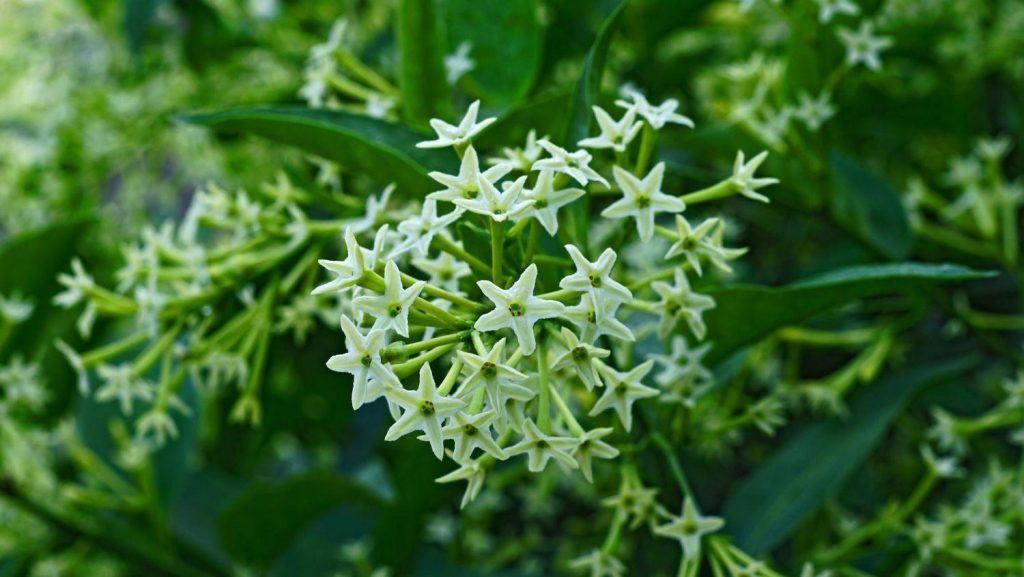
Night-Blooming Jasmine, also known as “Lady of the Night,” is not a true jasmine. This evergreen shrub features clusters of tubular, greenish-white flowers that emit an intoxicating, sweet fragrance throughout the night. The scent is so strong that it can fill a garden, making it a popular choice for evening landscapes.
Colors and Care: This shrub features greenish-white or yellow tubular flowers that emit a strong fragrance at night. It flourishes in full sun and moderate moisture conditions and can reach up to 10 feet in height.
Popularity: Originating from the West Indies and South America, Night-Blooming Jasmine is cultivated worldwide for its perfume and essential oils.
History: Known for its intoxicating scent, it has been a part of gardens for centuries and is sometimes associated with cultural significance and allure.
Benefits: It has been used traditionally for its anti-inflammatory and antimicrobial properties, and in treating conditions like arthritis and epilepsy.
3. Four O’Clocks (Mirabilis jalapa)
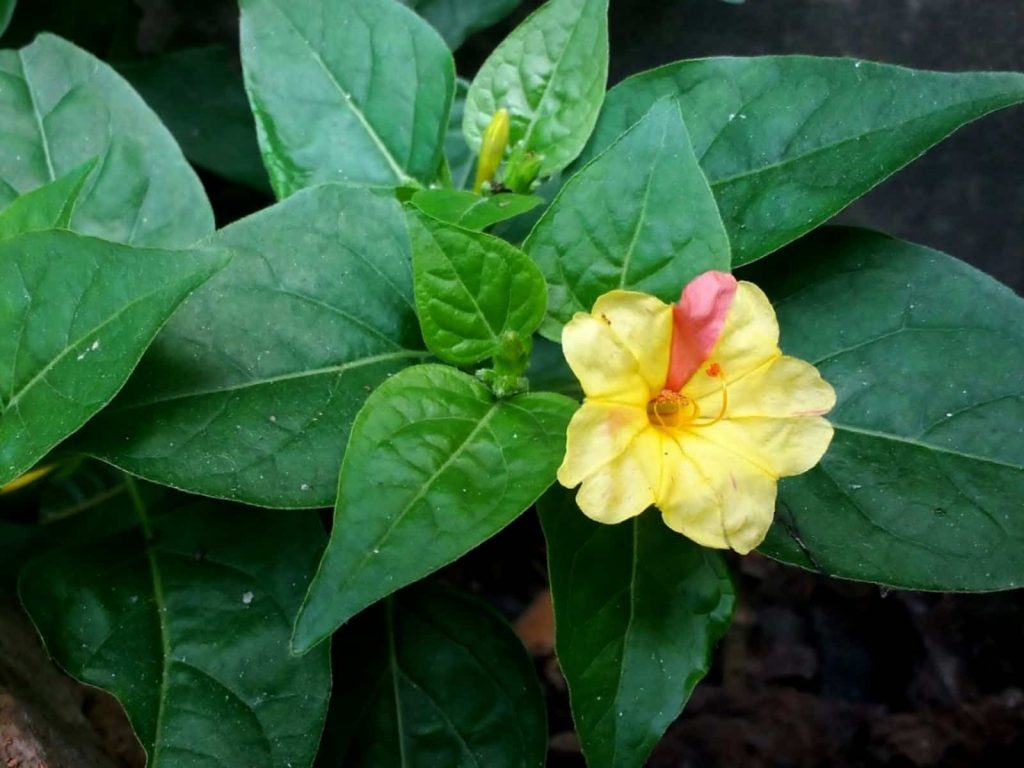
These cheerful trumpet-shaped blooms come in a vibrant range of colors, including red, pink, yellow, and white. Night-blooming flowers, Four O’Clocks typically open in the late afternoon and stay open throughout the night, attracting night-flying pollinators. However, some varieties may also bloom during the day.
Four O’Clocks symbolize strength with their vibrant blooms reliably appearing each afternoon, even in challenging conditions.
Colors and Care: Four O’Clocks display a kaleidoscope of colors, including red, yellow, pink, white, and bicolor. Also they are easy to grow, tolerating poor soil and drought, but prefer organic-rich, well-drained soil. Deadheading is not necessary, but it can encourage more blooms.
Popularity: Native to tropical South America, Four O’Clocks are cherished in gardens for their vibrant colors and fragrance. They open their flowers around 4 p.m., hence their name.
History: Cultivated for hundreds of years, these flowers were used by indigenous people for medicinal purposes and brought to Europe around.
Benefits: While primarily ornamental, all parts of the plant are toxic, so they should be handled with care, especially around pets and children.
4. Night Blooming Cereus – Queen of the Night
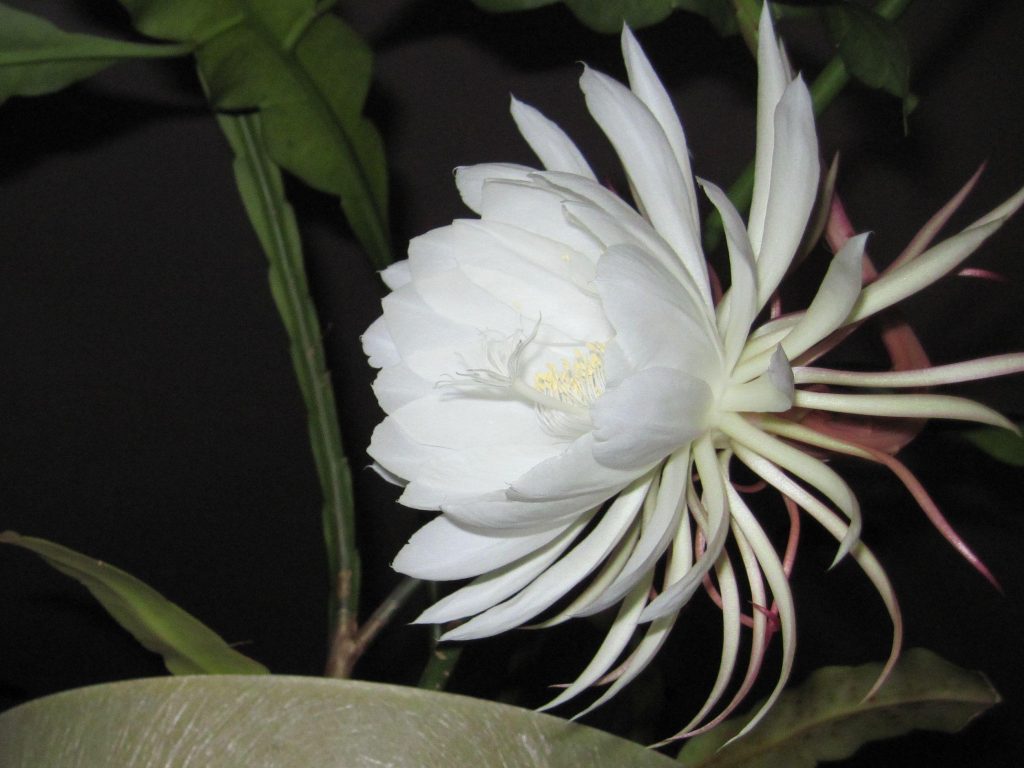
A true legend of the floral world, the Night Blooming Cereus stuns with its enormous, white flowers that can reach up to 12 inches in diameter. Blooming only at night for a single night a year, this rare cactus is a true spectacle to behold.
Colors and Care: They prefer filtered light or morning sun and need protection from hot afternoon sun. However regular watering is essential, but the soil should be allowed to dry out between waterings.
Popularity: This plant has been cultivated in Europe since the late 1700s and is a true epiphyte found from Mexico to Brazil.
History: Known as Cereus Jamacaru or mandacaru cactus, it originates from South America and has been used in traditional medicine.
It has been used for rheumatism, itchy rashes, worms, cystitis, fever, and even diabetes by various Native American tribes.
5. Tuberose (Polianthes tuberosa)

These elegant white flowers boast a heady, intoxicating fragrance that intensifies at night. Night-blooming flowers, Tuberoses are a popular choice for adding a touch of luxury to evening gardens and floral arrangements.
- Colors and Care: Often hailed as the “Queen of the Night,” the tuberose stuns with its intoxicating fragrance and elegant blooms. This night bloomer features clusters of waxy, white, funnel-shaped flowers that unfurl on tall spikes throughout summer and fall. Their captivating scent intensifies at night, attracting moths and other night pollinators. Tuberoses prefer full sun and well-drained, moist soil. However, they are not frost-tolerant and need to be lifted and stored over winter in colder climates.
- Popularity: Native to Mexico, tuberoses are prized worldwide for their beauty and fragrance. Also they are popular choices for cut flower arrangements, adding a touch of elegance to weddings and evening events. In some cultures, tuberose is associated with purity and devotion.
- History: Cultivated for centuries, tuberoses were cherished by the Aztecs for their medicinal properties and symbolic meaning. Meanwhile, their captivating fragrance has been used in perfumes for centuries, and they continue to be an important component in the essential oil industry.
- Benefits: Beyond their captivating beauty and fragrance, tuberoses offer several benefits. However their essential oil has a calming and uplifting effect, promoting relaxation and reducing stress. Additionally, tuberose plants can help purify the indoor air by removing toxins.
6. Casablanca Lily (Lilium ‘Casa Blanca’)
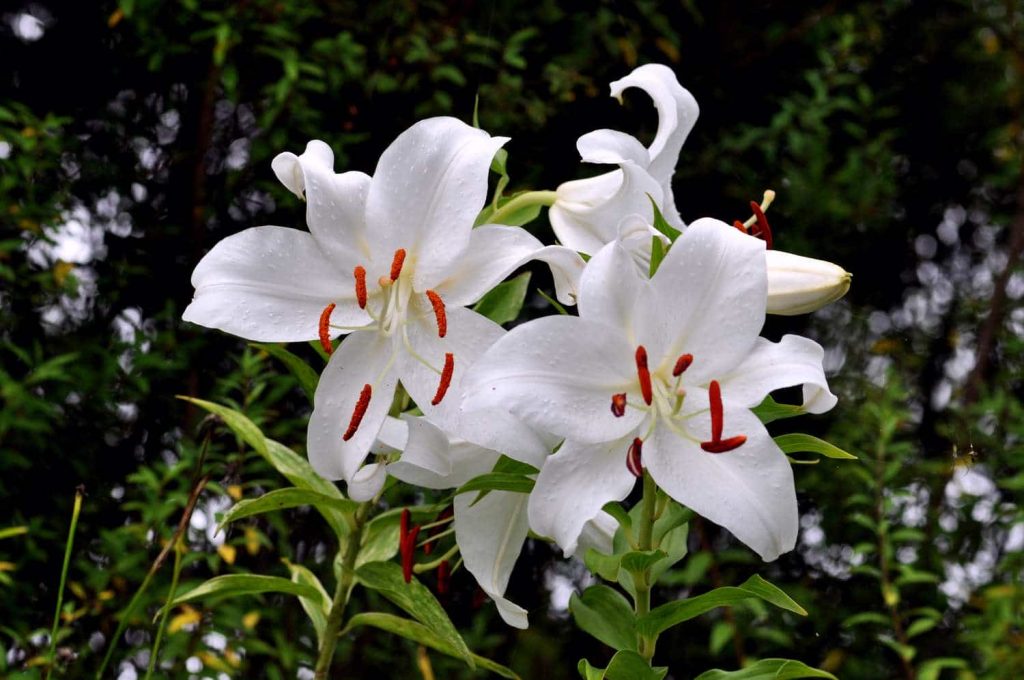
Known for their classic beauty and powerful fragrance, Casablanca Lilies don’t shy away from the night. These majestic white blooms with a hint of green in the center bloom at night and fill the evening air with their sweet scent.
- Colors and Care: This night-blooming giant boasts majestic, pure white, trumpet-shaped blooms that unfurl after sunset. Also Casablanca lilies thrive in cooler climates with well-draining soil and moderate watering. Their intoxicating fragrance intensifies at night, attracting moths for pollination.
- Popularity: Nicknamed the “Queen of the Night” in some cultures, the Casablanca lily is a symbol of purity and elegance, particularly beloved in wedding bouquets and evening gardens. They have a rich history, originating in Asia and cultivated for centuries.
- Benefits: While primarily admired for their beauty and fragrance, Casablanca lilies can also help purify the indoor air by removing toxins.
7. Flowering Tobacco (Nicotiana alata)
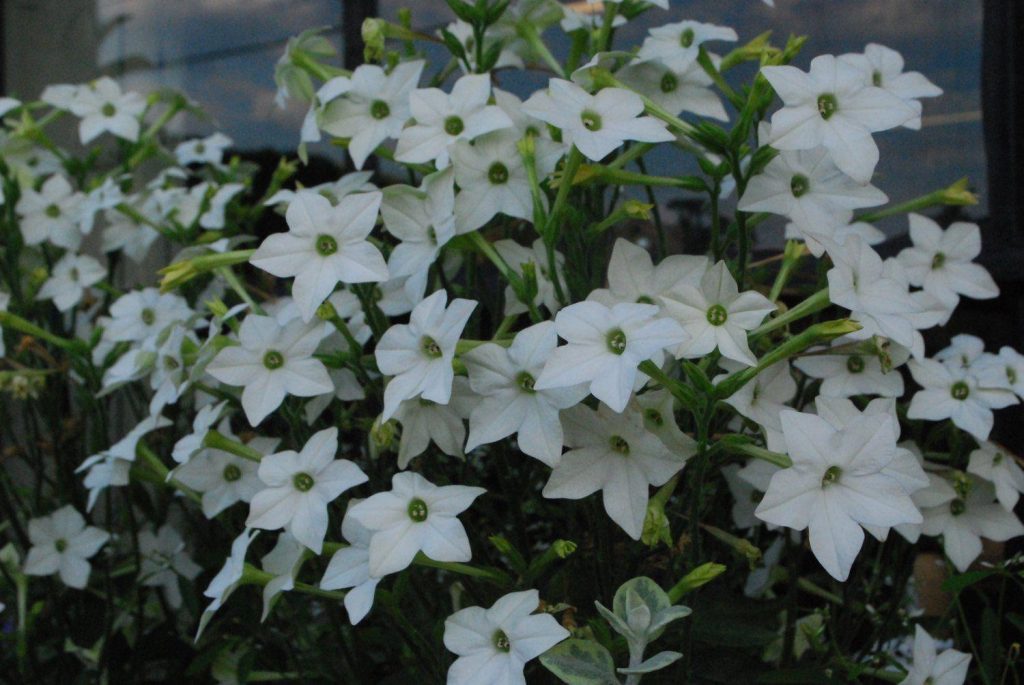
Flowering Tobacco is a night-blooming plant that produces clusters of tubular flowers in various colors, including white, pink, and red. The flowers open in the late afternoon and emit a strong, sweet scent throughout the night. Despite its name, Flowering Tobacco is not the same plant used to produce tobacco products.
- Colors and Care: Adorned with star-shaped blooms in shades of white, pink, and red, flowering tobacco is a favorite for night gardens. Night-blooming from late spring to summer, they release a sweet, jasmine-like fragrance that’s especially potent in the evening, attracting moths and hummingbirds. These beauties prefer full sun and well-drained soil, but be cautious as some parts are toxic if ingested.
- History: Flowering tobacco is native to South America and was introduced to Europe in the 18th century. It has been used ornamentally for centuries and even played a role in traditional medicine.
8. Gardenia (Gardenia jasminoides)
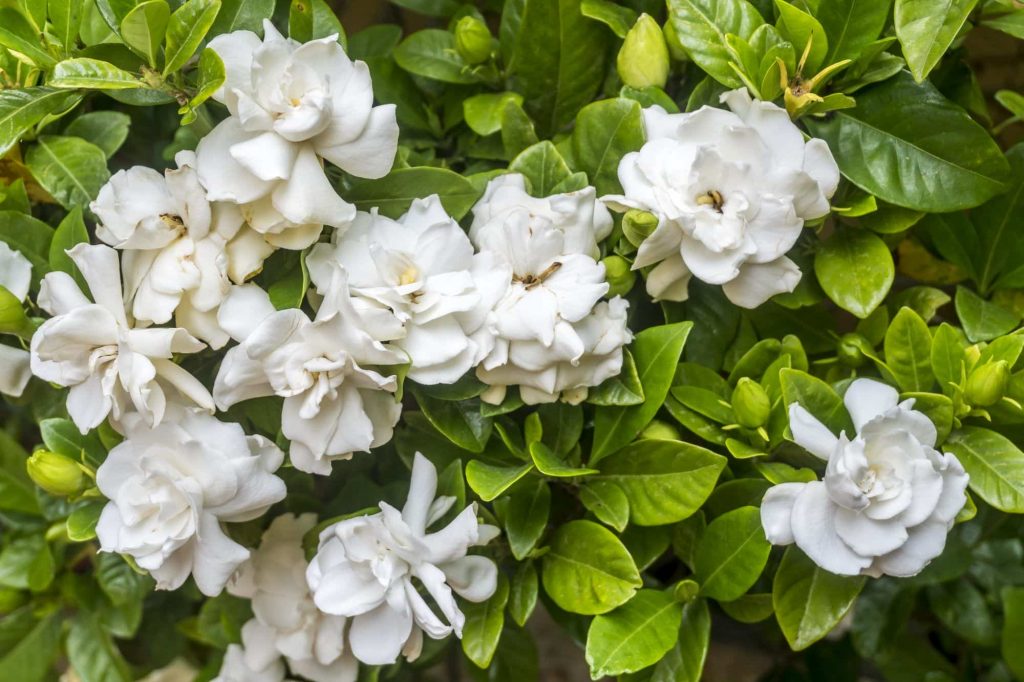
Gardenias are evergreen shrubs known for their glossy, dark green leaves and fragrant, white or yellow flowers. The flowers bloom in the evening and stay open throughout the night, filling the air with a sweet, intoxicating scent.
- Colors and Care: Celebrated for their intoxicating scent for centuries, gardenias are evergreen shrubs boasting beautiful white, double blooms. Also these fragrant ambassadors of the night unfurl their petals at dusk, filling the air with their sweet perfume throughout the night. Gardenias prefer warm, humid environments and consistent moisture for optimal growth.
- Popularity: Hailing from Asia, gardenias have captivated cultures worldwide with their symbolic meaning of love, purity and joy. However they are popular choices for weddings and as fragrant additions to indoor spaces.
9. Night Gladiolus (Gladiolus tristis)

The Night Gladiolus is a species of gladiolus that blooms at night. It produces tall spikes of yellowish-white flowers that open in the late afternoon and emit a spicy, clove-like fragrance throughout the night. These flowers that symbolize remembrance and strength.
- Colors and Care: This night bloomer is a true gem for fragrant gardens. Night gladiolus boasts creamy-white flowers flushed with green or pale yellow, sometimes described as having dark markings. These funnel-shaped blooms unfurl progressively on tall, wiry stems throughout spring, emanating a sweet fragrance that intensifies in the evening. Night-blooming from dusk onwards, their scent has been compared to carnation, clove, almond, or even honeysuckle. Also Night gladiolus thrives in well-drained soil and a warm location. However, they may not be suited for colder climates.
- Popularity: Native to the marshy grasslands of southern Africa, night gladiolus is a cherished addition to gardens for its delicate blooms and captivating fragrance. Also they are particularly loved in areas with warm climates where they can flourish throughout spring.
- History: With a historical range extending to parts of Australia and coastal California, night gladiolus may have been introduced to these regions unintentionally.
- Benefits: Night gladiolus attracts night-flying pollinators like moths with its sweet fragrance, promoting biodiversity in the garden. However they are also a beautiful cut flower option for evening events, offering a touch of elegance and a delightful nighttime scent.
10. Night Phlox (Zaluzianskya)
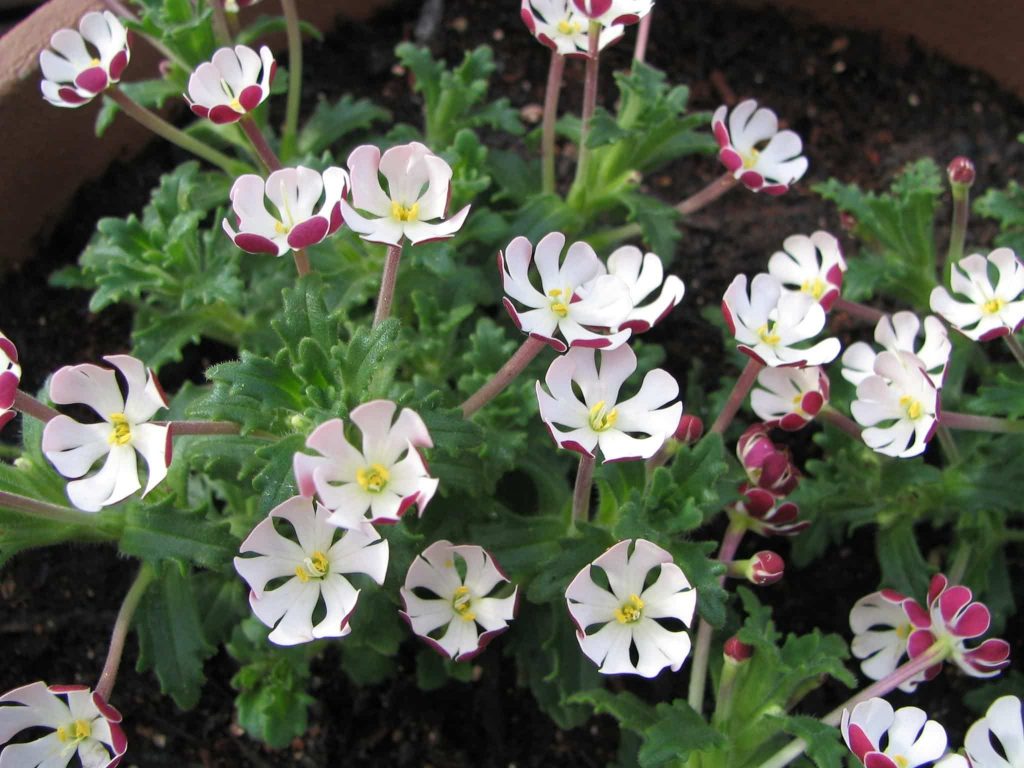
Night Phlox, also known as Midnight Candy, is a night-blooming plant that produces clusters of white, star-shaped flowers. The flowers open in the evening and release a sweet, honey-like fragrance that can fill an entire garden.
- Colors and Care: This South African native offers a charming contrast to the larger blooms mentioned above. Night phlox features tiny, daisy-like blooms in vibrant shades of purple that unfold in the late afternoon and emit a delightful honey-like fragrance throughout the night. However these low-maintenance wonders thrive in well-drained soil with moderate watering.
- Benefits: Night phlox attracts beneficial insects like butterflies and lacewings to the garden, helping control pest populations naturally.
11. Chocolate Daisy (Berlandiera lyrata)
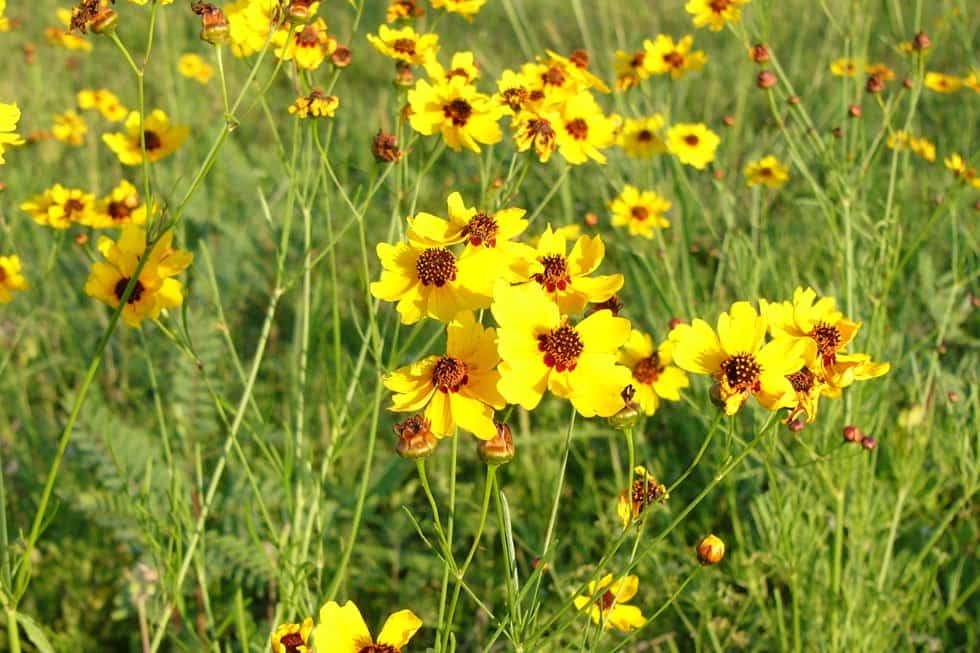
The Chocolate Daisy is a perennial plant that gets its name from the strong, cocoa-like fragrance of its flowers. The plant produces bright yellow, daisy-like flowers that bloom in the evening and stay open until the next morning.
- Colors and Care: Unlike its name suggests, the chocolate daisy doesn’t boast chocolate-colored blooms. Instead, this night bloomer unfolds golden yellow, daisy-like flowers in the evening, a beacon for night pollinators. Chocolate daisies are relatively low-maintenance, thriving in well-drained soil and full sun. However, deadheading spent blooms can encourage continued flowering throughout the summer.
- Popularity: Native to North America, chocolate daisies are cherished in wildflower gardens for their ecological benefits and cheerful blooms. Also they attract butterflies, bees, and other beneficial insects, making them a valuable addition to any pollinator-friendly garden. They symbolize loyalty and comfort.
- History: Chocolate daisies hold a special place in some Native American cultures, where they were used medicinally for various ailments. Meanwhile, their unique name comes from the faint chocolate-like scent emitted by their leaves when crushed.
12. Red Flare Water Lily (Nymphaea ‘Red Flare’)
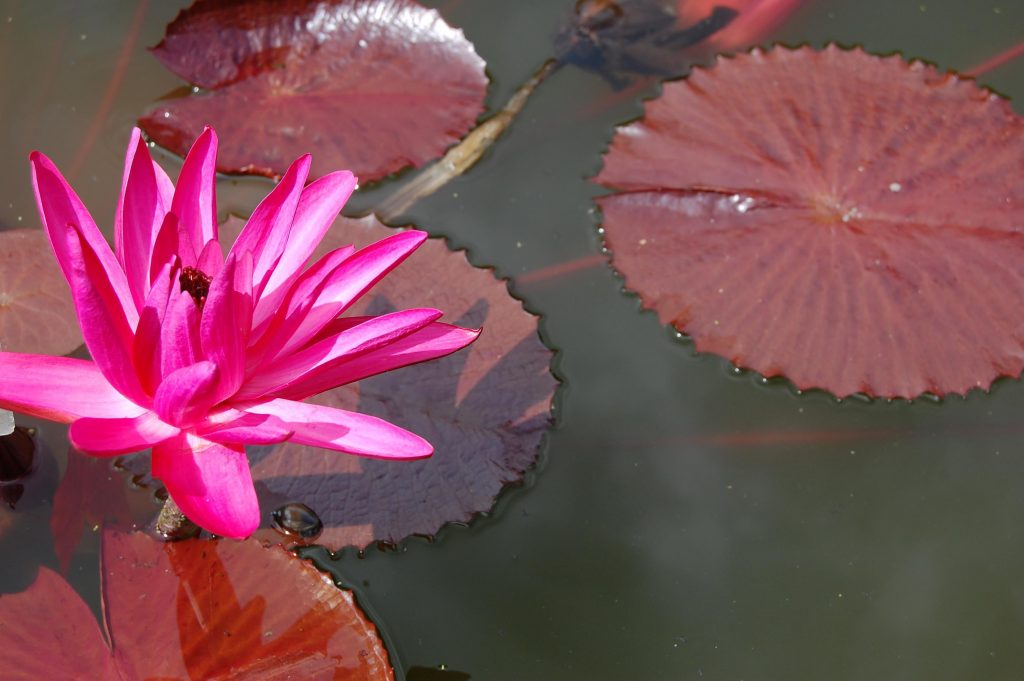
The Red Flare Water Lily is a night-blooming water lily known for its stunning, crimson-red flowers. The flowers open in the evening and stay open until the next morning, floating elegantly on the water’s surface.
Colors and Care: In contrast to the usual daytime bloomers of its kind, the red flare water lily awakens at dusk. This night-blooming aquatic beauty lives up to its name with fiery red blooms that rise majestically above the water’s surface, creating a breathtaking spectacle under the moonlight. Night blooming from summer to early fall, these lilies prefer still water and full sun exposure.
Popularity: The red flare water lily is a captivating addition to ponds and water gardens, particularly beloved for its vibrant color and night-blooming habit. It adds a touch of exotic beauty to any water feature.
Benefits: Red flare water lilies provide shade and cool water for fish, while their large blooms offer a nighttime food source for night-feeding pollinators like bats.
13. Foamflower (Tiarella cordifolia)
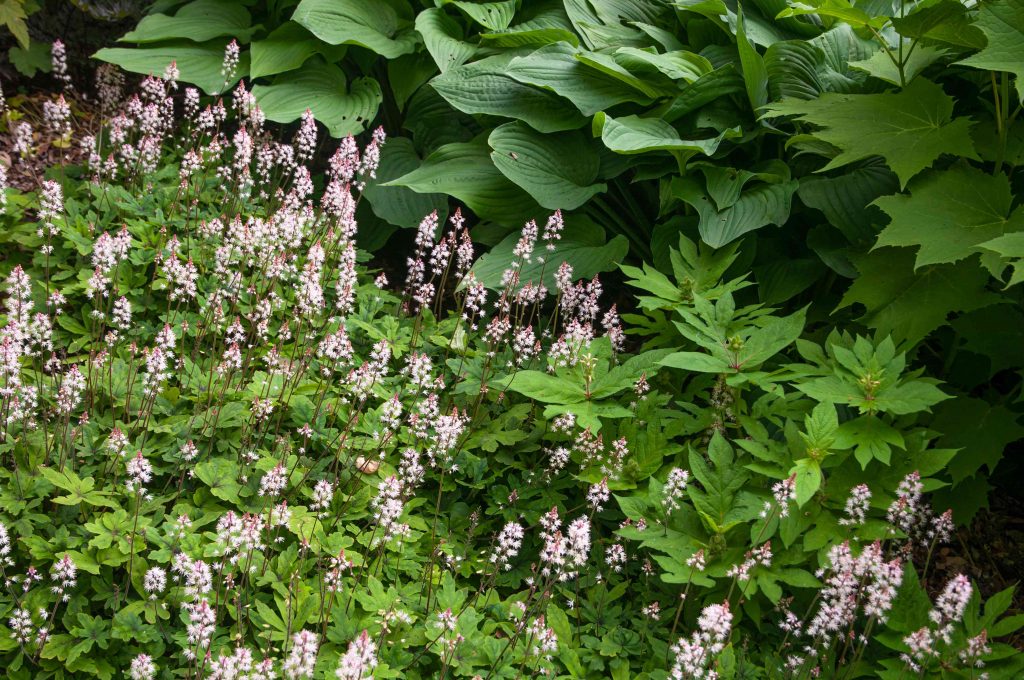
The Foamflower is a perennial plant that produces feathery, white flowers that bloom at night. The flowers are arranged in a spike-like cluster and give off a faint, sweet fragrance. The plant gets its name from the frothy appearance of its flowers.
- Colors and Care: While not a true night bloomer, foamflower offers a unique evening display. Its delicate, white, bell-shaped flowers open in the late afternoon and remain open throughout the night, bathed in the cool moonlight. Foamflower thrives in shady or partially shaded areas with moist, well-drained soil.
- Popularity: A favorite for shade gardens, foamflower offers beautiful texture and delicate blooms throughout the summer. They are also known for their attractive, heart-shaped foliage that adds visual interest even after the flowers fade. They symbol of healing and connection.
- Benefits: Foamflower is a low-maintenance groundcover that helps suppress weeds and retain moisture in the soil. They also attract beneficial pollinators like bees and hummingbirds, making them a valuable addition to any shade garden.
Summary Of Flowers That Bloom at Night: Represent the Moon
| Flower Name | Color | Symbolism |
|---|---|---|
| Moonflower | White | Purity, love, and mystery |
| Night-Blooming Jasmine | Greenish-white or yellow | Romance, sensuality, and attraction |
| Four O’Clocks | Pink, red, yellow | Time passing, change, and anticipation |
| Night Blooming Cereus | White | Secrets, transformation, and fleeting beauty |
| Tuberose | White | Passion, sensuality, and forbidden desires |
| Casablanca Lily | White | Celebration, purity, and elegance |
| Flowering Tobacco | Various colors | Sensuality, temptation, and allure |
| Gardenia | White or cream | Love, purity, and grace |
| Night Gladiolus | Pale yellow | Strength, remembrance, and infatuation |
| Night Phlox | White or pink | Dreams, mystery, and enchantment |
| Chocolate Daisy | Brown and yellow | Gratitude, loyalty, and comfort |
| Red Flare Water Lily | Red | Passion, enlightenment, and transformation |
| Foamflower | White or pink | Gentleness, healing, and connection |
Are There Plants That Grow in Moonlight?
Yes, there are several plants that can grow in moonlight. These plants are adapted to low light conditions and can photosynthesize using the light from the moon and stars.
What Kind of Plants Work in a Moon Garden?
A moon garden is a garden designed to be enjoyed in the evening or at night. However Plants that work well in a moon garden are those that bloom at night or have white or light-colored flowers that reflect moonlight. Some examples include Moonflower, Night-Blooming Jasmine, Four O’Clocks, and Casablanca Lily.
